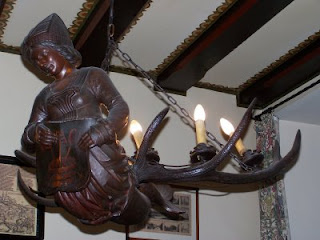



We made our final stop on our first evening in Bamberg at Schlenkerla Heller-Brau Trum, home of the world famous Aecht Schlenkerla Rauchbier and one of the big reasons I wanted to visit Bamberg.
Schlenkerla is like other Franconian brewpubs in that you enter from the street into a hall and then open a second door that brings you inside the tavern. You usually will not find a bar. Instead, you will be taken to one of a series long tables in the room that has seats available. There you will join strangers already enjoying beer or in the middle of a meal. This feels odd the first time you do it, but that soon passes as you get the feel for the Bamberg beer culture. A busy bartender is visible, expertly pouring half liter “Willy” glasses, and waiters and waitresses fill trays, whisking them to the tables.
At Schlenkerla, Matthias Trum, the sixth generation of his family to run the brewery, joined us to talk about the beer while we had dinner. The smoked beer and conversation went extremely well with the schweinhaxe (pork knuckle) and potato dumpling on my plate.
Trum says that today’s smoked beer is a throwback to the middle ages when brewers did not have access to the heat exchangers developed in England during the industrial revolution to kiln dry barley. In some parts of the world, ancient brewers could simply spread barley in the sun to dry. In Germany, the weather during most months meant maltsters needed to use open fires to dry malt. Where there is fire, there is smoke.
“Rauchbier is historic beer. Beer as it used to be,” says Trum.
While the smoke flavor notes add to the enjoyment of the beer, drying the barley over the beechwood fires also has beneficial aspects to the brewing process. According to Trum, just like smoking is a natural way to preserve meat, smoking barley provides a high degree of biological, chemical and flavor stability to his beer.
It is important to note that smoking barley is a different process than roasting barley. Roasted barley is what gives stouts and porters a dark color. In the smoking process the barley is on grates and is directly contacted by the smoke from the open fires. The barley in this process is at a much lower temperature than is found when barley is roasted, which resembles what takes place in roasting coffee beans. The barley in roasting kettles spins while the malt is toasted to the desired color level.
Schlenkerla produces 15,000 hectoliters of beer a year. In addition to the standard version of the Rauchbier, I also got a chance to try the fall seasonal Urbock. This brew tastes slightly less smoky, with more hop character and more malt used in the brewing process. The traditional Schlenkerla Rauchbier is 5.1 percent alcohol by volume, while the Urbock is a hefty 6.5 percent.
Schlenkerla also makes a Rauchweizen and a Smoked Lent Beer that uses 50 percent unfiltered beer and has a red color. Trum calls this a “liquid snack” to help people who might be cutting back on certain meals during the pre-Easter observances.
Trum is proud of the brewery’s heritage and the quality of its products. He is a booster of German beer in general, pointing out that while there is less diversity in beer styles in Germany when compared to Belgium or America, he feels the overall quality is higher.
That statement might draw protests from brewers in those countries, but you cannot argue with the unique quality of Trum’s rauchbier. It’s one of the reasons why one of the places American brewers usually visit when they travel to Germany is Schlenkerla.
No comments:
Post a Comment